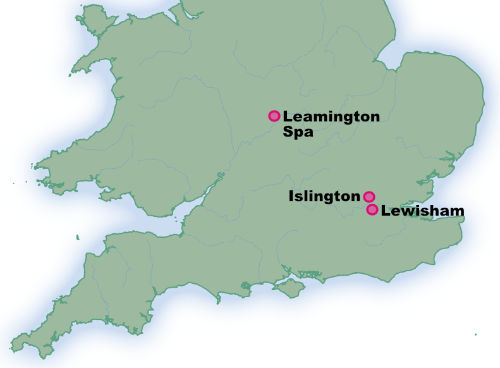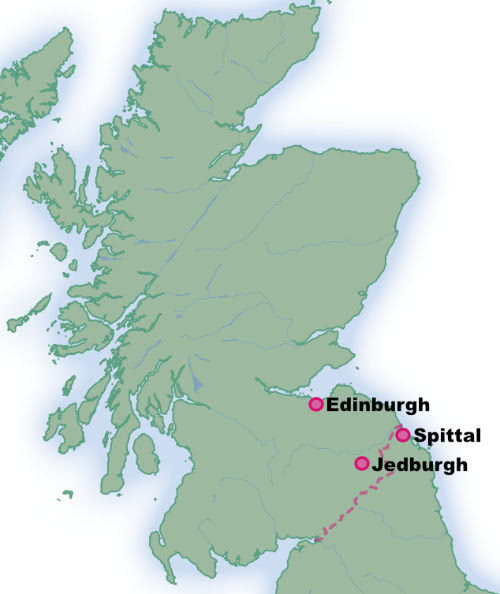David Lindsay's Family Background
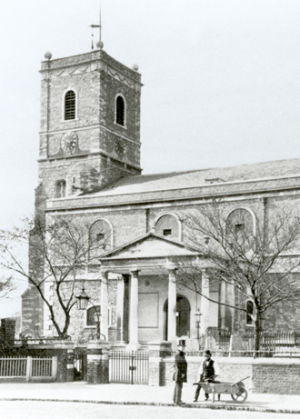
St Mary's Church, Lewisham. Image from Ideal Homes: A History of South-East London Suburbs
On the 1st of October 1868, David Lindsay’s parents, Alexander Lindsay and Elizabeth Bellamy, were married at St Mary’s Church in Lewisham. Neither had been born in, or even near, London. Together they would have three children, Alexander (born 1869), Margaret (born 1873), and David (born 1876), and would remain married until Alexander père’s disappearance in 1888, when he failed to return home from work, and much later proved to have left England entirely to start a new life in Canada.
In this article, I’ve presented the results of research I carried out into David Lindsay’s mother’s and father’s families, using family history records, newspaper archives, and some other online resources. My intent was to verify and, where possible, extend some of the points made in the biographical sources we have about Lindsay’s life, using data that would not have been at all easily accessible to Lindsay’s biographers. I finish with a section looking at a few points from the biographies in the light of this research.
David Lindsay’s mother Elizabeth was born on 10th December 1839, the third of three daughters to Thomas and Elizabeth Bellamy in Leamington Spa, Warwickshire.
Leamington Spa was enjoying a boom at this time, thanks to its reputation as a fashionable resort, after its spa waters (which had been known in Roman times) were rediscovered in 1784, and the town became the destination for wealthy holidaymakers.
Thomas Bellamy (probably born 1803) was a glazier in 1835,[1] but by 1837 was noted as plumber.[2] In fact, the two occupations were often combined in those days, as “plumber” covered any work using lead, including drainpipes, roofing, and the lead-work that held the glass in windows. His wife Elizabeth Standford[3] was born in 1801, and his two older daughters were Mary Ann (Marianne in some records), born in 1834, and Mildred, born in 1837. The family lived on Regent Street in Leamington Spa’s “New Town” area, north of the River Leam.[4]
Thomas Bellamy died in 1845,[5] after which his wife earned her living as a fishmonger and poulterer[6], a business that had started while her husband was still alive.[7] The Leamington Spa Courier has announcements in various years between 1845 and 1862 that she’s been granted a licence to sell game. In 1862, however, she’s in court for bankruptcy,[8] and at her death, in 1863, she seems to have been living on Satchwell Street.[9] Though it runs directly off commercial Regent Street, Satchwell Street was then considered part of the town’s poor district,[10] but it's possible she was living with her sister Mary, whose husband Elias Wilcox was innkeeper at the Half Moon Inn on Satchwell Street.[11]
By this time, two of Mrs Bellamy’s daughters were married. First was Mary Ann, to Henry Edward Bolton Joyce, a printer’s compositor, in 1860.[12] Mary and Henry moved down to Islington (a borough of London),[13] but Henry, at least, was back in Warwickshire to witness the marriage of Mildred, in 1862, to Theodore Couchman,[14] another man in the printing industry. (In the 1851 census, Theodore was a printer’s compositor, again in Islington. Later, he’d give his profession as “printer”,[15] and “cashier to a printer’s firm”.[16]) In fact, both men worked for the same firm, the printer Spottiswoode & Co.[17] (a different firm from the more well-known Eyre & Spottiswoode, Ltd).
Although there’s no way to be sure what Elizabeth did next, it seems likely that, with her two married sisters living in London and her mother dead, she would have moved down to London to be with them. At the time of her marriage, Elizabeth gives her address as Warwick Villas in Lewisham, which is the Couchmans’ address. (Interestingly, Alexander Lindsay gives the same address. Perhaps he was a lodger there at the time?)
By the 1871 census, the three Bellamy daughters, all now married, some with children, are living in three consecutive houses in Lewisham: 3 Gye Cliff Villas (the Lindsays), 2 Gye Cliffe Villas (the Joyces), and 1 Gye Cliffe Villas (the Couchmans).
All three families would stay in and around Lewisham for much, if not all, of David Lindsay’s time there. The Joyces had four children, Edward Ernest (born 1865),[18] Kathleen (born 1868, died 1869),[19] Edith Marian (born 1871),[20] and Margaret Annie (born 1875).[21] Their father Henry was editor of The Shipping Gazette, chairman of the local conservative club, president of the local swimming club, a local vestryman, and a freemason.[22] He was declared bankrupt in 1896 while working as a “journalist’s manager”.[23] The same year, he attended the wedding of his youngest daughter (at which, the report in The Kentish Mercury says, one of her bridesmaids was “Miss Lindsay (cousin)” — i.e., David’s sister Margaret),[24] and another newspaper item says that, the following month, due to ill health, he is leaving Lewisham for a six month “tour” (holiday).[25] The 1901 census lists him as a retired journalist, visiting a house in Southampton.[26] He died in 1907;[27] I can’t find a record of his wife’s death, but it seems to be after his.
Mildred and Theodore Couchman had no children. Theodore began to involve himself in local politics, standing for the “Conservative and Moderate Interest”[28] in the Lewisham Vestry Election of December 1894.[29] By March the next year his post had to be voted for again as, after an illness, he died. After this, David Lindsay’s mother Elizabeth — who was now without her husband, too — and her family moved in with the widowed Mildred. (Mildred died in 1926. She, her husband, her sister Elizabeth, and her nephew (David’s brother) Alexander Lindsay, are all buried in Ladywell & Brockley Cemetery, marked by a single monument.[30])
I’m not going to go into the lives of David Lindsay’s cousins, except to note one interesting item. In the 1901 census, David’s brother Alexander is married and living at 6 Radford Road in Lewisham. The Kentish Mercury for 17th May[31] has a classified ad with one “Alex Lindsay” wanting to sell the freehold of 6 Radford Road. In 1911, this address is the home of the now-married Ernest Edward Joyce — David and Alexander’s cousin by his mother’s eldest sister — and a brood of four children. Ernest was, at this time, a journalist.
It’s evident from this look at David Lindsay’s mother’s family that the three Bellamy sisters were close, and that, with three cousins and two aunts and uncles living close by, David must surely have been in contact with this half of his extended family at least.
What of his father’s side?
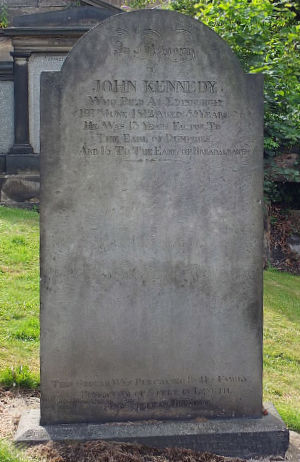
John Kennedy's grave at Old Calton Cemetary. Photo by Ad Meskens, on Wikimedia Commons
David’s father Alexander Lindsay was born in 1839 in Edinburgh,[32] to a family that already had a minor literary claim to fame. His mother Barbara (born 1810) was the daughter[33] of John Kennedy (1757–1812),[34] a friend of the poet Robert Burns.
A land factor (estate manager) to the Earl of Dumfries, and later to the Earl of Breadalbane,[35] John Kennedy has the honour of having a Burns poem (“To John Kennedy”) written to him, being lines included in a letter from Burns when the poet sent Kennedy a manuscript copy of another poem, “The Cottar’s Saturday Night”, in 1786.
Barbara Kennedy married Alexander Lindsay (i.e., David Lindsay’s grandfather, born 1801), an accountant,[36] in 1829.[37] He was one of fourteen children born to William Lindsay, a tenant farmer near the village of Fettercairn, about a hundred miles north of Edinburgh. The farm itself was part of lands that for a while belonged to the Earls of Crawford — whose surname was Lindsay — and indeed there may have been a distant connection with that family, as an obituary for the eldest of his brothers noted his as being “a cadet branch of the great family whose records long formed a large part of the history of this locality” (i.e., the Lindsays).[38]
Alexander Lindsay and Barbara Kennedy had six children: Charles William (born 1829), Anne (born 1830), Gilbert (born 1834), Robert (born 1836, though sadly seems to have died even before the 1841 census), Alexander (i.e., David Lindsay’s father), and Mary (born 1841).
Alexander senior worked as a clerk for J & R Raimes & Company, a wholesale druggist that would eventually become the current firm of Raimes, Clark & Co. Ltd., better known by their trading name of Lindsay & Gilmour Pharmacies, the largest independent pharmacy group in Scotland. (The “Lindsay” here refers to a Robert Lindsay who set up his pharmacy in Edinburgh in the early 19th century. He seems not to have been directly related to Alexander senior. You can read about the firm’s history here.) Among its many offerings, J & R Raimes sold Grimstone’s Aromatic Regenerator for the Growth of the Human Hair (which was also “a certain preventive of Head-ache and Fainting; also a toilet Perfume”), S Walker & Company’s Chemically Prepared Gun Wadding, Butler’s Cooling Aperient Powders (for digestive troubles), Old Parr’s Life Pills (which promised to cure, among other things, coughs, nervous afflictions, constipation, and rheumatism), Wildenow’s Preparations, Barker’s Gout and Rheumatism Pills, Hall’s Patent Starch, Moxon’s Magnesian Aperient (“a preventative for Piles”), Maw’s Portable Domestic Injection Instrument, Perry’s Purifying Specific Pills (“an effectual remedy in all cases of stricture and diseases of the urinary organs”), and the Concentrated Detersive Essence (“an anti-syphilitic remedy”).
In a similar pattern to Elizabeth Bellamy’s family, Alexander senior died in middle age, passing away on 15 January 1843,[39] leaving his widow to, in this case, make a living taking in lodgers.[40] Barbara herself died in 1861.[41]
Charles William died in 1845 at the age of 16, of a "decline". In 1851, Gilbert is a journeyman printer’s compositor,[42] but after that I can’t find any definite record of him. (A Gilbert Lindsay, printer from Scotland, arrived in America in 1853, so this could have been him.)
It’s a different matter with the sisters. Anne went on to be a teacher, and Mary an assistant teacher, the two sharing a house in Jedburgh.[43] Then, in 1882, Mary, the younger sister, married James Hilson.[44] The Hilsons were a prominent family in Jedburgh, owning several textile mills in the locality. James Hilson was manager of his father’s textile business (Messrs John & William Hilson), and would become a partner in it on his father’s retirement.[45] At the time of his marriage James was 26 and Mary was 39. Mary’s sister Anne (then aged 51) moved in with the couple,[46] and lived with them until her death in 1904. As a mark of the respect in which he held his wife, James changed his name to James Lindsay Hilson, his wife becoming Mary Lindsay Hilson. The couple had a daughter, Jessie Elizabeth Barbara Hilson, who was born in 1884, and died in 1940.[47] She was, for a time, organist at the Abbey United Free Church in Jedburgh. After James became a partner in his father’s textile business in 1893, the mill changed from a retail to a wholesale business, but the tweed trade entered a decline in Jedburgh, and the business eventually closed.
Every year, the Lindsay Hilsons and Anne Lindsay would cross the border to holiday in the seaside resort of Spittal,[48] and the local Berwick Advertiser would print lists of who had come to stay at the various resorts it covered. In 1887, the occupants of one boarding house are given as: “Mr and Mrs James Hilson, Miss Hilson, Miss Lindsay, Kenmore Bank, Jedburgh; Miss Lindsay, Mr David Lindsay, Lewisham, Kent.” (So this is David — who would have been 11 years old — holidaying with his sister, cousin, two aunts and an uncle.)[49] They all appear together again in 1889.[50]
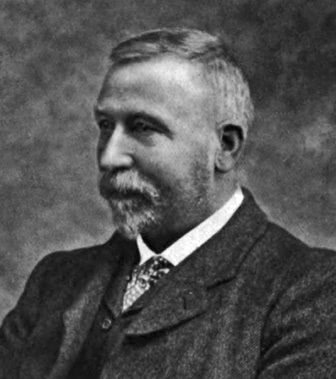
James Lindsay Hilson, image from Significant Scots
James Lindsay Hilson was something of a local figure, not just through being a businessman, but through involvement in the community. The list of societies he either formed, or took an important role in for at least part of their existence, is formidable: he was an original committee member of the Jedburgh Christian Fellowship Union; he conducted the Band of Hope; he was connected with the Jedburgh Gospel Temperance Union; he was a member of the Jedburgh Abbey United Free Church, also of the Jedburgh Literary Association, and the Mutual Improvement Association; he was secretary of the Jedburgh Musical Association until 1899; he was a member of the Town Council from 1882 for about 11 years, and of the Parish Council from 1904 to 1906; he was involved in the Jedburgh Liberal Association; he was also a member (and sometime secretary) of the Roxburghshire Liberal Association; also the Jedburgh Ramblers’ Club, of which he was vice-president at its inception in 1897, then Honorary Secretary and Treasurer three years later; he was Director of the Mechanics’ Institute Library; and was on the committee of the Public Library which replaced it; he became librarian when the Public Library was moved to Castlegate in 1900. One of his acts of charity was to see to the distribution of reading materials to various lonely outposts, such as lighthouses and railway signal boxes, in the vicinity.[51]
He also wrote articles for The Border Magazine, The Scotsman (as “J. L. H.”), The Jedburgh Gazette and The Kelso Mail, among others, some of which were later collected into books, including: Burns’s Border Tour, and Other Newspaper Articles (1907); Yesterdays with the Freeholders of Roxburghshire (1909); Wool and its Manufacture (1909); More Yesterdays in a Royal Burgh (1909); Yesterdays in the Middle Marches (1909); Border Parishes and Church Tokens (1909); Yesterdays with the “Vagabonds” on the Borders (1909); Yesterdays with the Boys’ Brigade (1910); Jedburgh Typography, 1817-1845 (1915); and Berwick-upon-Tweed Typography, 1753-1900 (1919).
A speech (which can be read here), given in his honour on the occasion of his retirement from the post of Librarian at the Jedburgh Public Library, lists many of these achievements, and also notes that he has, through his wife, inherited John Kennedy’s bureau, in which the manuscript of Burns’s poem, for a short while at least, was stored.
Mary died in 1918,[52] James in 1928.[53]
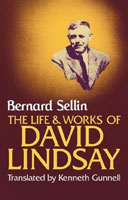
In The Life & Works of David Lindsay, Bernard Sellin says that David’s mother came from a “farming family”,[54] when it seems that her immediate family, at least, were based in the centre of Leamington Spa’s “New Town”. This gives a slightly different flavour to her background than to think of her as coming off a farm.
Sellin also states that a “favourite holiday venue was Illston, a small village in the Border district, near Jedburgh, where an uncle owned a textile factory”.[55] This uncle is undoubtedly James Lindsay Hilson. “Illston”, though, is most likely “Ulston”, a village that became part of Jedburgh.
Before David married, it’s said he had an understanding or engagement with a cousin. Sellin says: “The family clan schemed to marry the London branch to its Scottish roots; David Lindsay would marry a cousin from Jedburgh, whom he saw each summer during his holidays in Scotland. Started in the early 1900’s, the engagement slowly dragged on and on.”[56] I can’t be sure I’ve traced all of Lindsay’s cousins (missing any definite information on his uncle Gilbert, I can’t tell if he married and had a family, thus providing another potential cousin), but to me it sounds as though this “cousin from Jedburgh” is Jessie Hilson, who was eight years David’s junior, and who remained unmarried throughout her life.[57]
The most interesting discrepancy arising from my research relates to a statement in J B Pick’s “Sketch of Lindsay’s Life as Man and Writer”. On page 7 of The Strange Genius of David Lindsay, he says, about the fallout from David’s father’s disappearance:
“[David] had won a scholarship to the University, and would have liked to go, but was not allowed to do so by his grandmother, who was responsible for the family at that time.”
If my research is correct, all of David’s grandparents were dead before he was born, so it can’t have been a grandmother who stopped his entering further education. It’s possible, though, that, on the disappearance of David’s father, the Lewisham Lindsays would have turned to the Jedburgh Lindsay Hilsons for help, or at least advice. After all, at this time, James Lindsay Hilson was the manager of a successful textile mill, and his wife Mary and sister-in-law Anne, both living with him, would have been the closest surviving family on David’s father’s side. Did the two Lindsay aunts make the decision that David would have to turn down his scholarship and start earning money? If so, David’s maiden aunt, Anne — 57 at the time and the oldest family member, and significantly older than David’s uncle James, so she might have seemed, to David’s 13-year-old eyes, as old as a grandmother — could have fallen into the matriarchal role, at least in the way that the story was passed from David to his wife, and from her to J B Pick, years later.

Footnotes
- 1^ — Mary Anne Bellamy baptism record, 1st Feb 1835
- 2^ — Mildred Bellamy baptism record, May 14th 1837
- 3^ — Marriage Bond prepared 17 May 1827 at Birmingham, between Thomas Bellamy, plumber, and Elizabeth Stanford of Leamington Prior. The marriage was on 20 May 1827
- 4^ — Census Records show them living at 60 then 61 Regent Street, 1841, 1851, 1861. Elizabeth Bellamy's bankruptcy (London Gazette, Feb 7th 1862) shows her living at 71 Regent Street.
- 5^ — Burial record, 19th February 1845, Leamington Spa, All Saints
- 6^ — Census records 1851, 1861
- 7^ — An 1842 directory lists Thomas Bellamy of 61 Regent Street among Poulterers & Dealers in Game.
- 8^ — The Leamington Spa Courier, 8th Feb 1862, page 1, and London Gazette, Feb 7th 1862.
- 9^ — The Leamington Spa Courier, 7th November 1863, p. 7
- 10^ — See Nineteenth Century Slums in Leamington Spa, at Discover Royal Leamington Spa.
- 11^ — At least until 1861 (Census record for Half Moon Inn, 35 Satchwell Street).
- 12^ — Warwickshire Marriages record, 22nd August 1860, Marianne Bellamy and Henry Edward Joyce
- 13^ — 1861 Census, 17 Roman Terrance, Islington
- 14^ — 14th August 1862, Theodore Edward Couchman and Mildred Bellamy
- 15^ — 1871 Census
- 16^ — 1881 Census
- 17^ — In April 1959, for instance, both Henry Joyce and Theodore Couchman are playing for the Spottiswoode cricket team. See The Era, Sunday 11 September 1859, p. 14
- 18^ — Birth records, Lewisham, 1st quarter of 1865
- 19^ — Baptism record 11th November 1868, Lewisham; Death record 4th quarter 1869, Lewisham
- 20^ — 1871 Census, Hither Green Gye Cliffe Villa, Lewisham
- 21^ — Baptism record 3rd October 1875, Lewisham
- 22^ — These from numerous mentions in local papers, and in The Freemason periodical.
- 23^ — London Gazette, 28th January 1896
- 24^ — The Kentish Mercury, 17th April 1896, p. 5
- 25^ — The Kentish Mercury, 1st May 1896
- 26^ — 1901 Census for 10 Vincents Walk, Southampton
- 27^ — Lloyd’s List, 23rd May 1907, p. 9
- 28^ — Kentish Mercury, 29th March 1895
- 29^ — Kentish Mercury, 7th December, p. 4
- 30^ — Gravestone Photographic Resource, Theodore Edward Couchman
- 31^ — p. 8
- 32^ — 1841 Census for Leith Walk, Leith, Midlothian
- 33^ — As mentioned in this page on James Lindsay Hilson
- 34^ — John Kennedy at The Burns Encyclopedia
- 35^ — See the gravestone at Wikimedia Commons
- 36^ — See, for instance Mary Lindsay's marriage certificate, 29th March 1882
- 37^ — Marriage record, 5th January 1829, Edinburgh Parish, Edinburgh
- 38^ — Obituary for Robert Lindsay, Dundee Evening Telegraph, 26th Feb 1884, p. 4.
- 39^ — Lindsay, Alexander (Wills and testaments reference SC70/1/63, Edinburgh Sheriff Court Inventories, from ScotlandsPeople.com
- 40^ — 1851 Census for 26 Pitt Street, Edinburgh
- 41^ — Death record, April 24th 1861, District of St Andrew
- 42^ — 1851 census for 26 Pitt Street
- 43^ — 1871 Census for 65 Canongate, Jedburgh
- 44^ — Marriage record, 29th March 1882
- 45^ — Most of these details from Significant Scots — Lindsay Hilson
- 46^ — Census records for the family for 1891 and 1901
- 47^ — Death record, 28th Jan 1940
- 48^ — The Berwickshire News, 15th Sep 1925, p. 5
- 49^ — The Berwick Advertiser, 12 August 1887
- 50^ — The Berwickshire News, 13th August 1889 and 20th August 1889
- 51^ — Most of these details from Significant Scots — Lindsay Hilson
- 52^ — Death record, 26th January 1918
- 53^ — Death notice in The Berwickshire Advertiser, 6th Dec 1928
- 54^ — Sellin, p. 8
- 55^ — Sellin, p. 10
- 56^ — Sellin, p. 17
- 57^ — I assume this as I can't find a marriage record, and her death record has her still with her maiden name.


